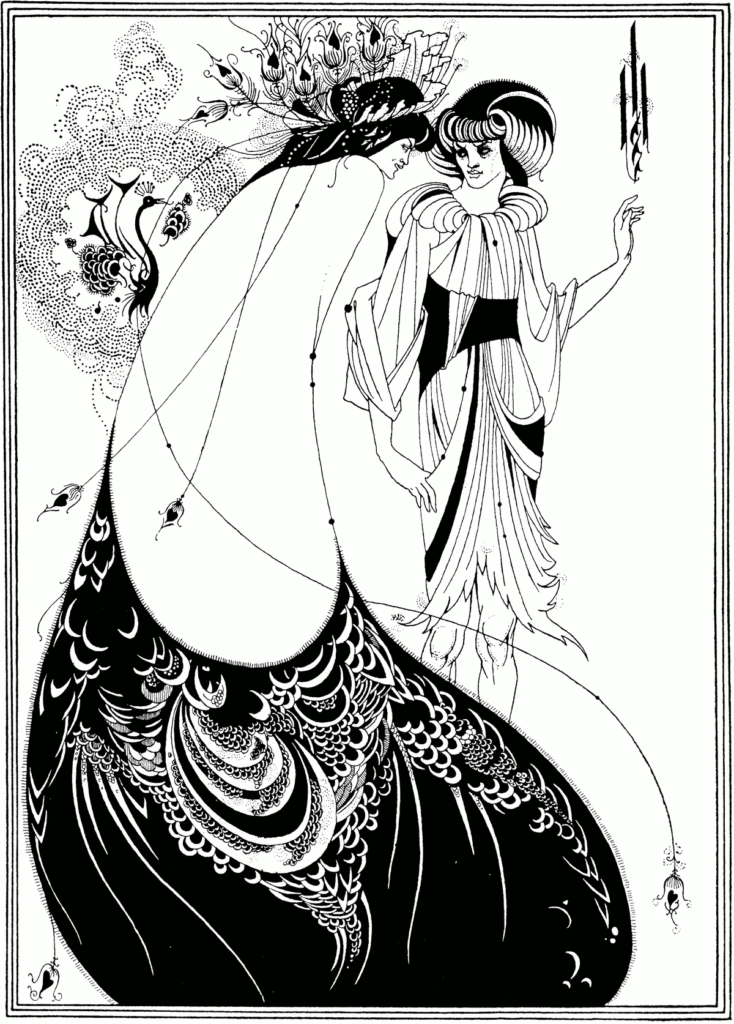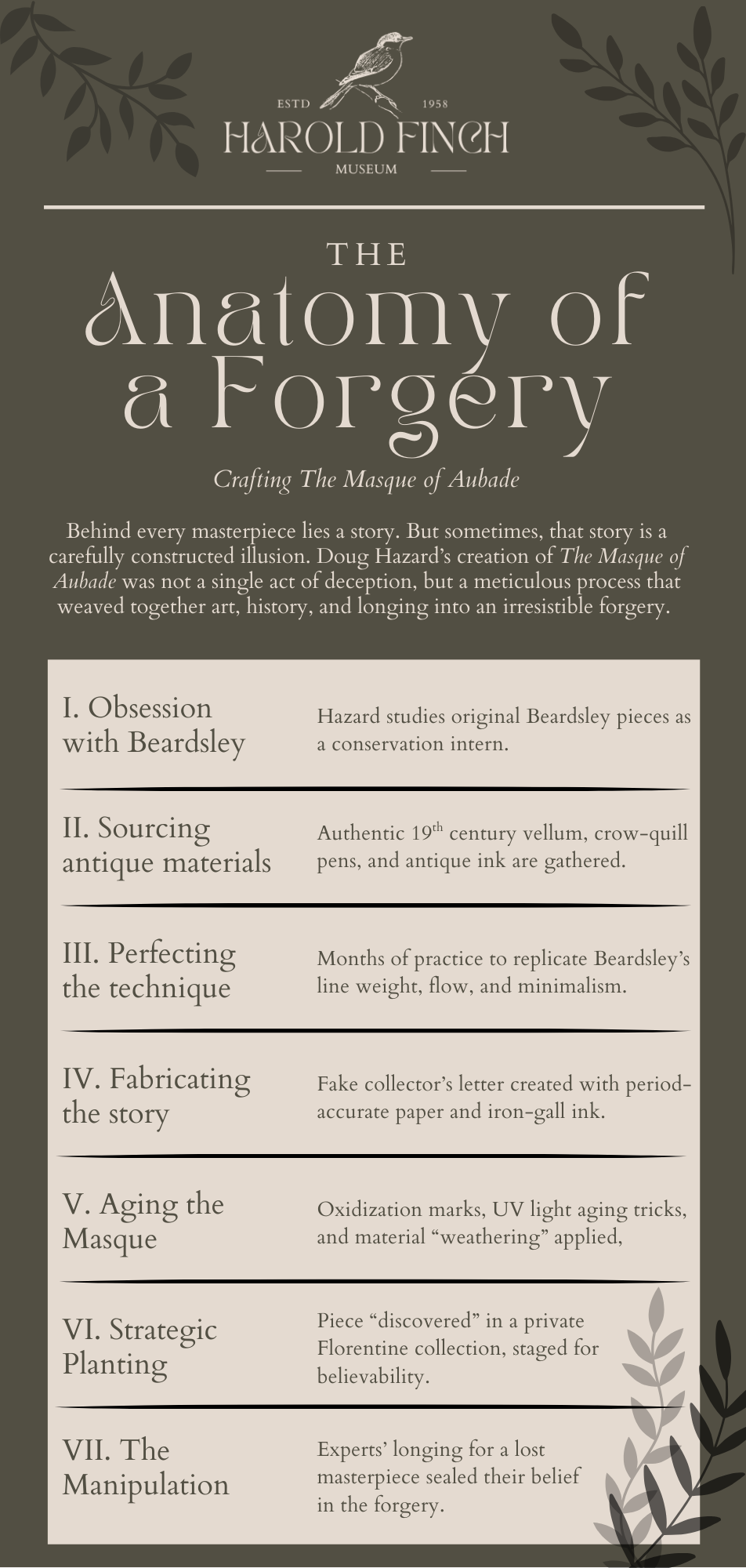
The Harold Finch Museum
Established 1958
Where art transcends the human experience, and history breathes anew. Dedicated to the preservation, discovery, and celebration of artistic masterpieces, renowned and forgotten. We curate not merely objects, but legacies.
Curated by Johnny Schlamme
Since 1958, The Harold Finch Museum has been dedicated to presenting not only the triumphs of artistic achievement but also the intricate stories that challenge our understanding of authorship, value, and truth. In this special feature, Senior Collections Fellow Johnny Schlamme investigates The Masque of Aubade, a forged drawing in the style of Aubrey Beardsley, crafted by Doug Hazard. Schlamme explores why, despite its deceptive origins, it remains a vital part of the museum’s education mission.
The Masque of Aubade is now housed in our permanent collection as a cornerstone of our “Authenticity and Illusion” initiative. The piece is used in curatorial training, public lectures, and educational programming to provoke critical dialogue surrounding connoisseurship, material analysis, and the psychology of belief. The Masque of Aubade allows students, scholars, and visitors to grapple with the ethics of forgery, the allure of lies, and the uneasy boundary between fraud and genius.
An Introduction
When the faded parchment first came to light, scholars wept at its beauty, collectors fought for a glimpse, and connoisseurs whispered one name: Beardsley. Yet behind the swirling lines and languid figures lay a secret, a masquerade crafted not by a feverish hand in the late 1890s, but instead by a man hunched over a cracked plastic table in the dim glow of a condemned apartment complex.
It was there, amid peeling paint and broken promises that Doug Hazard gave life to The Masque of Aubade, a work destined to blur the line between devotion and deception. Its discovery would set in motion a chain of events that would rattle the art world to its very foundations.
“In every flawless line, there echoes the heartbeat of a beautiful lie.”
Harold Finch, Museum Founder, on The Masque of Aubade
Born in 1872, Aubrey Beardsley transformed the late Victorian art world with his provocative, stylized black and white illustrations. As art editor of The Yellow Book and illustrator of Oscar Wilde’s Salome, Beardsley pushed the boundaries of morality, gender, and beauty through a stark, fluid visual language that both scandalized and excited. His work embodied the spirit fo the aesthetic and decadent movements, confronting his reserved society with images that suggested far more than they revealed.
Despite suffering from tuberculosis throughout his short life, Beardsley’s output was prolific and fearless. In his final years, his sudden conversion to Catholicism and plea for the destruction of his works only deepened the reverence of his followers. Beardsley died at twenty-five, his death leaving a void the art world has never fully filled.

and Albert Museum.
The Discovery
When The Masque of Aubade first surfaced, it seemd nothing short of a miracle. A singular black ink drawing, attributed to Aubrey Beardsley and dated 1897, the piece evoked the spirit of an artist lost too soon. Rendered in sweeping India ink on aged vellum, it captured a procession of masked figures dissolving into the first light of dawn. An image drenched in symbolism, echoing Beardsley’s obsession with decadence, identity, and mortality. Preliminary analysis only deepened the mystery: UV light revealed consisted ink aging, and fiber testing matched late 19th century vellum. With no prior record of this piece, experts theorized it had been created for an unrealized edition of Maeterlinck’s Pelléas and Mélisande, after being unearthed from a private collection in Florence. The art world, desperate for Beardsley’s final act, embraced it with little question, setting the stage for one of the greatest deceptions in modern art history.
A Reveal
The truth unraveled not with a revelation in a lab, but with a quiet confession. Doug Hazard, an unassuming former illustrator turned art forger, revealed that The Masque of Aubade was not Beardsley’s final masterpiece, but a fabrication born of obsession and precision. Working in obscurity, Hazard employed antique inks, crow-quill pens, and vellum sourced from a 19th century calligrapher’s estate. He forged not merely a drawing, but an entire story: a collector’s letter aged with iron-gall ink, fabricated provenance, and a carefully seeded rumor linking the piece to Beardsley’s unfinished ambitions.

Hazard’s mastery extended beyond technique, “I didn’t copy him,” Hazard confessed, “I became him. I wrote a new page in our autobiography.” His greatest deception was not in the forgery itself, but in the longing it provoked, invoking the irresistible hope that Beardsley’s hand might have left one more billowing trace behind.
The Aftermath
Even after its exposure, The Masque of Aubade refuses to be dismissed. It lingers in the cultural imagination, suspended between artifact and apparition, a reminder that authenticity is often less powerful than belief. Collectors grieve its fall from grace; scholars debate its place in a museum; and some viewers, even knowing the truth, continue to return to it.
“I gave them the ending to Beardsley’s work that they always wanted,” Hazard said. In this way, The Masque of Aubade transcends its origins: no longer merely a drawing, nor simply a deception, but a testament to the human hunger for an ending, and the beautiful illusions we willingly embrace.
The Purpose
Following the public revelation of its true origins, The Masque of Aubade found a permanent home at The Harold Finch Museum, not as a dismissed forgery, but as a living testament to the complexity of art, authenticity, and human desire.
The museum chose to acquire and display the piece not merely as a cautionary tale, but as an invitation for visitors to confront the uncomfortable question it raises: What defines artistic value? Is authenticity rooted in the creator’s hand, or the emotions a piece evokes? The Masque of Aubade endures here not despite its falsehood, but because of the powerful truth its deception forces us to reveal about ourselves.
“Of course, I have one aim, the grotesque. If I am not grotesque I am nothing.”
Aubrey Beardsley, 1896
